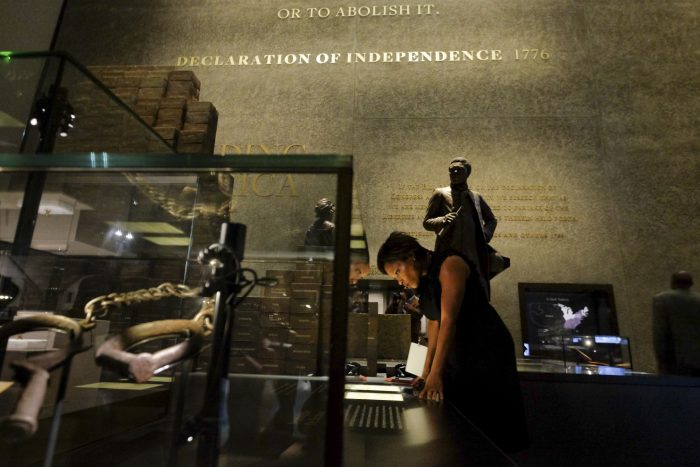“To walk in here, to be here, to see this magnificent museum. It’s going to continue to take me back,” he said in an interview taped Friday. “Just walking through here, I almost cried. I don’t want you to make me cry.” Read more from Emily Schultheis for CBS News.
For parents and children, difficult history at African American Museum
The Washington Post, Sept. 18, 2016

A pair of slave shackles on display in the Slavery and Freedom Gallery at the National Museum of African American History and Culture. (Chip Somodevilla/Getty Images)
The new National Museum of African American History and Culture is in part a celebration of black heritage, a commemoration of civil rights leaders and a reflection on aspects of the past that still cast a shadow on American society. Read more from T. Rees Shapiro for The Washington Post
Here’s What It’s Like To Walk Through The First National Black History Museum
The Huffington Post, Sept. 19. 2016

A woman poses with a sculpture of freed slave Clara Brown at the National Museum of African American History and Culture as the new museum holds its media preview day on Sept. 14, 2014.(Photo By Bill Clark/CQ Roll Call)
When you step into the elevator on the top floor of the David M. Rubenstein History Galleries, there’s a timeline to your right. It begins with the word “Today.”
Pay attention to it.
As you descend, the timeline will lead you back into history, past President Barack Obama’s 2008 election, through the civil rights movement and Jim Crow. You’ll glide past Reconstruction, the Civil War and the height of African enslavement in the New World. Soon, the elevator will reach its destination: the belly of the National Museum of African American History and Culture. Read more from Julia Craven for The Huffington Post.
Making a Way Out of No Way: Defending African-American Culture
The Root, Sept. 19, 2016

An exhibit is displayed during a press preview at the Smithsonian’s National Museum of African American History and Culture in Washington, D.C., on Sept. 14, 2016. (Photo by Preston Keres/AFP/Getty Images)
The mainstreaming of black American culture has ripped it from its roots. We have to take it back.
I’m black and have always identified as such, and until recently, I never questioned exactly what that meant. Having grown up on the outskirts of Washington, D.C., formerly known as Chocolate City, attended an HBCU and worked at two black companies in the past, I’ve been happily surrounded by myriad black people. Read more from Tracy L. Scott for the Root.
‘Enthusiasm has been overwhelming’: African-American history museum prepares for huge crowds
USA Today, Sept. 23, 2016

Middle Passage Shackles (wrought iron), c. pre-1863
Ankle shackles of the type used to restrain enslaved people aboard ships crossing the Atlantic from Africa to the Americas, during the Middle Passage.
Of the thousands of artifacts that will be displayed at the National Museum of African American History and Culture, none give Mary Elliott the chills like the shackles that were used on children transported on slave ships from Africa, or the whip used to keep slaves in line.
“The thought of someone gearing up to whip someone with that – that will never leave my mind,’’ said Elliott, a curator at the new Smithsonian museum.at – that will never leave my mind,’’ said Elliott, a curator at the new Smithsonian museum. Read more from Deborah Berry Barfield for USA Today.
WATCH: Smithsonian Previews National Museum of African American History on Facebook Live
News4-Washington, Sept. 21, 2016
…Curators launched six Facebook Live videos Wednesday, exploring everything from the symbolism of the building to the Tuskegee Airmen exhibit. Watch the videos at News4-Washington.
For Those Who Lived Through 60s, Smithsonian’s New African-American Museum Has Special Meaning
Forbes, Sept. 21, 2016

March on Washington for Jobs and Freedom, Martin Luther King, Jr. and Joachim Prinz pictured, 1963. Via American Jewish Historical Society/Wikimedia Commons.
‘Here they will be reminded of the truth’

The Smithsonian’s National Museum of African American history and Culture. (Photo by Chip Somodevilla/Getty Images)
On Saturday, the 400,000-square-foot National Museum of African American History and Culture will open to the public near the base of the Washington Monument. In this post, Leslie T. Fenwick, dean emerita of the Howard University School of Education and a member of the Scholarly Advisory Committee for the new museum, writes about what it means to her, and she looks back at a museum experience years ago that remains embedded in her memory. Fenwick, a professor of education policy at Howard, held consecutive terms as a presidentially appointed visiting fellow and visiting scholar in education at Harvard University from 1999 to 2003. A former urban schoolteacher, school administrator and legislative aid to the Ohio Senate, she became a noted education-policy scholar. She was appointed to the National Academy of Sciences’ committee on the study of the effects of mayoral control on public schools, and she is regularly called upon to testify about educational equity and teacher quality to the U.S. Senate, National Conference of State Legislatures, U.S. Conference of Mayors, National Urban League, and Congressional Black Caucus, among other groups. Read more from Valerie Strauss for the Washington Post.
Oprah is a “dancing emoji,” thanks to the Smithsonian’s newest museum
CBS This Morning, Sept. 23, 2016
The Smithsonian’s new National Museumof African American History and Culture had Oprah Winfrey dancing Friday Morning, one day before it officially opens to the public.
“It is moving and profound,” Winfrey said. “I’m actually a dancing emoji today, a dancing emoji. I’m so happy!” Winfrey exclaimed, dancing in front of the museum on the National Mall in Washington D.C. Read more from Rebecca Lee for CBS News and watch the complete interview.
“The history lesson I never got in school”
CBS News 60 Minutes, Sept. 23, 2016
As the new African-American history museum opens, 60 Minutes producer Nicole Young talks about the artifacts that affected her most. Read more from Nicole Young for CBS News and watch the complete segment.
‘Thinking of the past, considering the future.’ Inside the African American History and Culture Museum.
The Washington Post, Sept. 24, 2016

Danielle Robinson, of Chicago, closely reads a rough draft of the Declaration of Independendence behind slave shackles during the grand opening of the Smithsonian’s National Museum of African American history and Culture. “It is interesting to hee how it has been written to exclude us…Everyone has to know our true history.” (Jahi Chikendiu / The Washington Post)
I am in the building, but mostly I’m in my head.
Thinking of the past, considering the future. Mesmerized by the right now.
This building, the National Museum of African American History and Culture, is monumental in scale. Grand and breathtaking with its elegant filigree panels of bronze-tinted aluminum. The light bounces off the metal, pulling the eye upward, and the building glows. It tugs at emotions, too, because it’s been so long in coming — a century-long dream, a decade-long endeavor. Read more from Robin Givhan for The Washington Post.
A pre-Civil War haven for free blacks is now honored in the African American Museum
The Washington Post, Sept. 25, 2016

Lyles Station, Ind. is a 200 year old farming community that was settled by free African Americans before the Civil War. Stanley Madison grew up in Lyles Station and has dedicated his life to preserving the story of his ancestors. (Erin Patrick O’Connor/Video by: Erin Patrick O’Connor/ Photo by: Bonnie Jo Mount)
The sun is just dawning over a parking lot wedged between a cornfield and a Bob Evans in southwestern Indiana. The farmers arrive early. This is like sleeping in for them. The prospect of this pilgrimage to Washington makes them proud, nostalgic and a little edgy.
“It’s a busy time to be going,” says Glenn Morris, who raises cattle and crops on 425 acres a couple miles away. “You’re wondering if you should be on the trip or in the field.” Read more from David Montgomery for The Washington Post.








